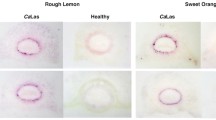Abstract
Chimeric constructs with the hydrophilic octapeptide FLAG epitope (DYKDDDDK) have been widely used as multipurpose tags for identification, detection, and purification of FLAG fusion proteins. Constructs consisting of C-terminal FLAG-tagged genomic and cDNA clones of anArabidopsis phytochelatin synthase gene,AtPCS1, were used in developing transgenic lines of Indian mustard. Presence and expression ofAtPCS1 in transgenic lines were confirmed by using PCR and Northern blot analyses. However, immunoblot analysis revealed strong nonspecific binding of a monoclonal anti-FLAG M2 antibody to an endogenous protein in both shoot and leaf tissues of wild-type Indian mustard (85-kDa) that masked presence of the phytochelatin synthase (PCS) protein of interest (55-kDa). Further analysis revealed absence of a nonspecific protein in root tissues of transgenic plants, thus allowing detection of the FLAG-tagged PCS protein.
Similar content being viewed by others
Abbreviations
- PC:
-
phytochelatin
- PCS:
-
phytochelatin synthase
- cDNA:
-
complementary DNA
- gDNA:
-
genomic DNA
References
Alarcon CM, Umthum AR, and Register JC III (2001) Use of epitope tags for routine analysis of transgene expression. Transgenic Res 10: 183–192.
Bradford MM (1976) A rapid and sensitive method for the quantitation of microgram quantities of protein utilizing the principle of protein dye binding. Anal Biochem 72: 248–254.
Chen J, Zhou J, and Goldsbrough PB (1997) Characterization of phytochelatin synthase from tomato. Physiol Plant 101: 165–172.
Chubert RG and Brizzard BL (1996) Vectors for expression and secretion of FLAG epitope-tagged proteins in mammalian cells. Biotechniques 20: 136–141.
Clemens S, Kim EJ, Neumann D, and Schroeder JI (1999) Tolerance to toxic metals by a gene family of phytochelatin synthases from plants and yeasts. EMBO J 18: 3325–3333.
Ferrando A, Farràs R, Jásik J, Schell J, and Koncz C (2000) Intron-tagged epitope: a tool for facile detection and purification of proteins expressed inAgrobacterium-transformed plant cells. Plant J 22: 553–560.
Grill E, Löffler S, Winnacker E-L, and Zenk MH (1989) Phytochelatins, the heavy-metal-binding peptides of plants, are synthesized from glutathione by specific γ-glutamylcysteine dipeptidyl transpeptidase (phytochelatin synthase). Proc Natl Acad Sci USA 86: 6838–6842.
Ha SB, Smith AP, Howden R, Dietrich WM, Bugg S, O'Conell MJ, Goldsbrough PB, and Cobbett CS (1999) Phytochelatin synthase genes fromArabidopsis and the yeastSchizosaccharomyces pombe. Plant Cell 11: 1153–1164.
Heiss S, Wachter A, Bogs J, Cobbett C, and Rausch T (2003) Phytochelatin synthase (PCS) protein is induced inBrassica juncea leaves after prolonged Cd exposure. J Exp Bot 54: 1833–1839.
Jarvik JW and Telmer CA (1998) Epitope tagging. Annu Rev Genet 32: 601–618.
Kolodziej P and Young RA (1991) Epitope tagging and protein surveillance. Methods Enzymol 194: 508–519.
Lee S and Korban SS (2002) Transcriptional regulation ofArabidopsis thaliana phytochelatin synthase (AtPCS1) by cadmium during early stages of plant development. Planta 215: 689–693.
Lee S, Moon JS, Ko TS, Petros D, Goldsbrough PB, and Korban SS (2003a) Overexpression ofArabidopsis phytochelatin synthase paradoxically leads to hypersensitivity to cadmium stress. Plant Physiol 131: 656–663.
Lee S, Petros D, Moon JS, Ko TS, Goldsbrough PB, and Korban SS (2003b) Higher levels of ectopic expression ofArabidopsis phytochelatin synthase do not lead to increased cadmium tolerance and accumulation. Plant Physiol Biochem 41: 903–910.
Lee SM, Moon JS, Domier LL, and Korban SS (2002) Molecular characterization of phytochelatin synthase expression in transgenicArabidopsis. Plant Physiol Biochem 40: 727–733.
Liere K, Kaden D, Maliga P, and Borner T (2004) Overexpression of phage-type RNA polymerase RpoTp in tobacco demonstrates its role in chloroplast transcription by recognizing a distinct promoter type. Nucl Acid Res 32: 1159–1165.
Murashige T and Skoog T (1962) A revised medium for growth and bioassays with tobacco tissue cultures. Physiol Plant 15: 473–479.
Ruotolo R, Peracchi A, Bolchi A, Infusini G, Amoresano A, and Ottonello S (2004) Domain organization of phytochelatin synthase: functional properties of truncated enzyme species identified by limited proteolysis. J Biol Chem 279: 14686–14693.
Schäfer K and Braun T (1995) Monoclonal anti-FLAG antibodies react with a new isoform of rat Mg2+ dependent protein phosphatase. Biochem Biophys Res Comm 207: 708–714.
Vatamaniuk OK, Mari S, Lang A, Chalasani S, Demkiv LO, and Rea PA (2004) Phytochelatin synthase, a dipeptidyltrasferase that undergoes multisite acylation with γ-glutamylcysteine during catalysis. J Biol Chem 279: 22449–22460.
Vatamaniuk OK, Mari S, Lu YP, and Rea PA (1999) AtPCS1, a phytochelatin synthase fromArabidopsis: isolation and in vitro reconstitution, Proc Natl Acad Sci USA 96: 7110–7115.
Vatamaniuk OK, Mari S, Lu YP, and Rea PA (2000) Mechanism of heavy metal ion activation of phytochelatin (PC) synthase. J Biol Chem 275: 31451–31459.
Zhu YL, Pilon-Smiths EAH, Jouanin L, and Terry N (1999) Overexpression of glutathione synthetase in Indian mustard enhances cadmium accumulation and tolerance. Plant Physiol 119, 73–79.
Author information
Authors and Affiliations
Rights and permissions
About this article
Cite this article
Gasic, K., Korban, S.S. Nonspecific binding of monoclonal anti-FLAG M2 antibody in Indian mustard (Brassica juncea). Plant Mol Biol Rep 23, 9–16 (2005). https://doi.org/10.1007/BF02772643
Published:
Issue Date:
DOI: https://doi.org/10.1007/BF02772643




